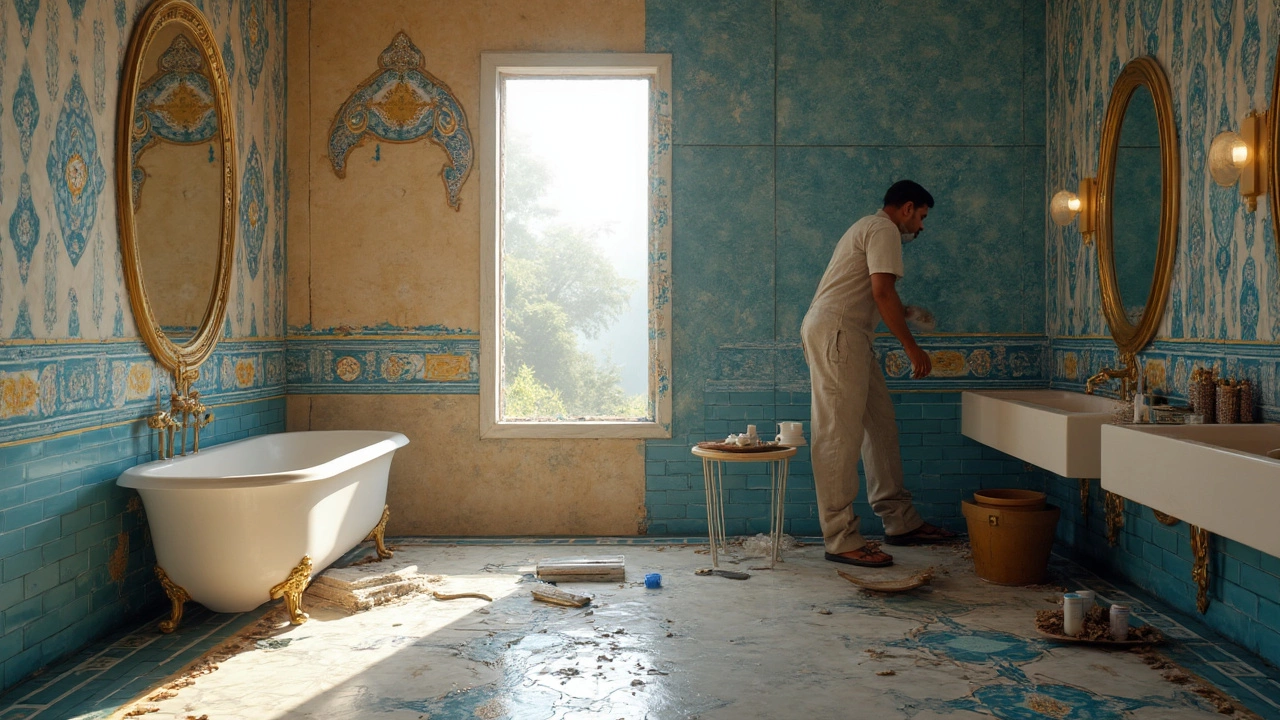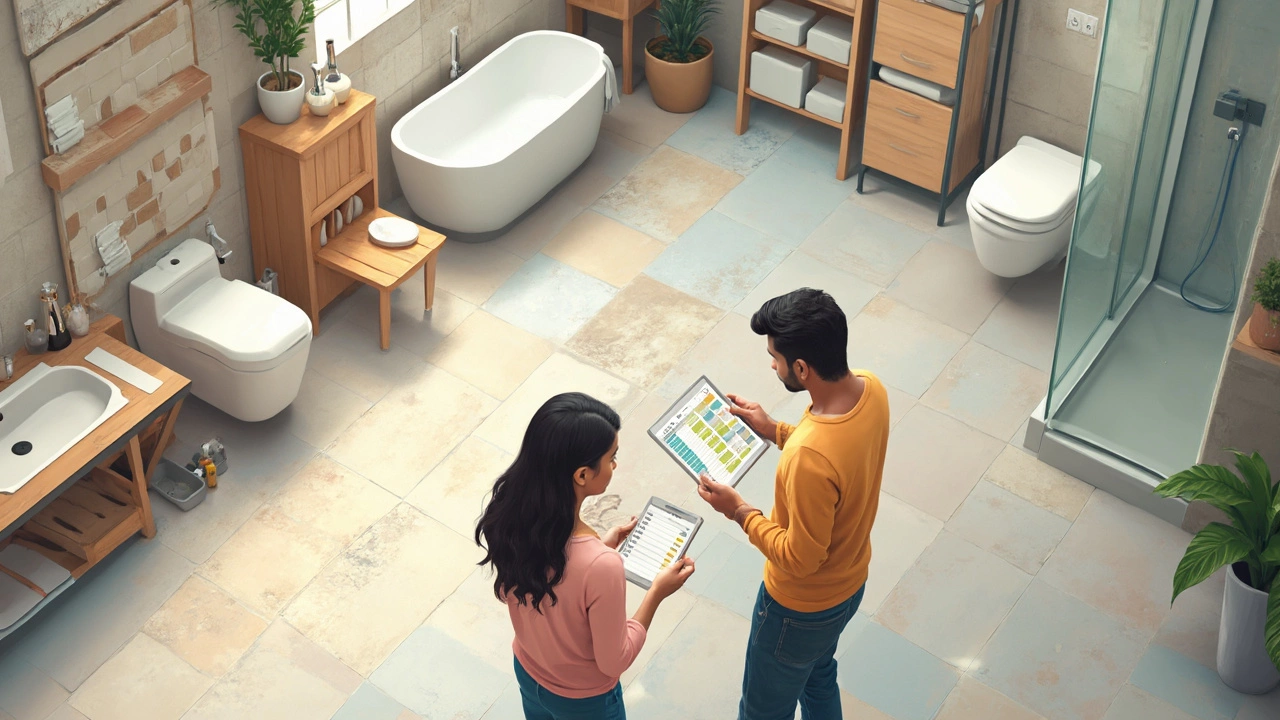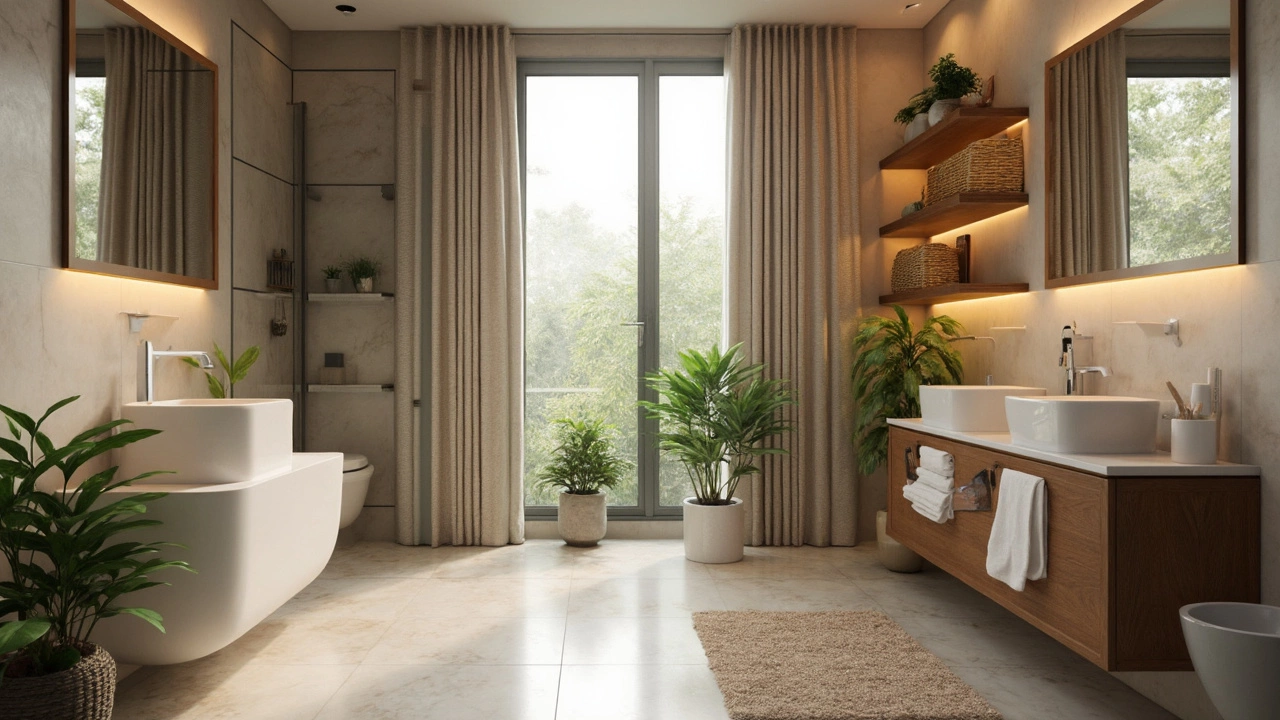Most Expensive Part of a Bathroom Remodel: What Eats Up Your Budget First?

Most folks think the priciest part of redesigning a bathroom is the fancy bathtub or maybe that slick rain shower. It's not. The biggest chunk of your money almost always disappears on tile work and labor costs. Surprised? Yeah, I was too. When Lyra and I tackled our bathroom update last year, the numbers made our eyes water—and it wasn’t because of that designer sink she liked.
It turns out, covering floors and walls with high-quality tile, especially with complex patterns, eats away at your budget fast. Add in the skilled labor to make it look sharp (and waterproof!), and suddenly, the cost per square foot leaps way up. Good installers aren't cheap for a reason—their work keeps you from dealing with leaks, mold, and cracked grout a year down the line. Cutting corners here almost always backfires.
- Where Your Money Actually Goes
- Why Tile and Labor Dominate Costs
- Sneaky Expenses Homeowners Miss
- Tips to Stretch Your Remodeling Budget
Where Your Money Actually Goes
If you dig into the cost of a typical bathroom remodel, you’ll quickly realize it splits up between a few heavy hitters—materials, labor, plumbing, and cabinets. Folks are surprised to see how fast the bills stack up, especially with pro work and high-end surfaces. Here’s what your remodel dollars are really paying for.
The National Kitchen and Bath Association broke down the average spending for a bathroom remodel. The stats say you’re looking at something like:
| Category | Percentage of Total Remodel Cost |
|---|---|
| Labor | 20-40% |
| Fixtures (toilet, tub, shower) | 15-20% |
| Cabinetry & Hardware | 15% |
| Flooring | 10-15% |
| Countertops | 7-10% |
| Walls & Ceilings | 5% |
| Doors & Windows | 4% |
| Design Fees | 4% |
| Lighting & Ventilation | 5% |
So, if your whole remodel runs about $20,000 (which is common for a mid-range job), you could easily spend $8,000 just on labor and another $3,000 on things like tiles and flooring. When you see that bathroom remodel cost broken down, it’s clear why folks end up over budget so often—little upgrades (like heated floors or a rainfall shower) knock your wallet even harder.
Want to know a sneaky detail? Labor can swing higher if you pick complicated tiles, custom cabinetry, or move plumbing. Every extra detail means more hours and higher bills. If you’re aiming to save, stick to what works in your space, and avoid anything that means rerouting pipes or tearing out walls. It’s the quickest way to keep your wallet from screaming.
Why Tile and Labor Dominate Costs
If you want to know where most of your bathroom remodel cost goes, look no further than tile and the people installing it. Tiles aren’t just picked for their good looks—high-quality ones are built to last in wet, steamy conditions and need special treatment to stop leaks. The price per square foot jumps up fast, especially for popular materials like marble, porcelain, and patterned ceramics.
But material is only half the story. Labor can actually be pricier than the tiles themselves. You’re not just paying someone to stick tiles on the wall; you’re paying for precision, proper sealing, and all the tedious prep work. Most bathroom tile jobs need special water-resistant layers underneath (like cement board or waterproof membranes) before the pretty stuff goes on. If your old bathroom wasn’t square or the walls are uneven, installers have to fix that first, and it adds up.
Check out this snapshot of what’s typical for bathroom tiling in the US:
| Item | Typical Cost per Sq Ft |
|---|---|
| Ceramic Tile | $3 - $7 |
| Porcelain Tile | $5 - $10 |
| Natural Stone | $10 - $30 |
| Tile Installation Labor | $7 - $20 |
See that last line? Skilled labor regularly equals or beats the cost of the tile itself. If you want a custom pattern, mosaic, or something special, expect those labor rates to climb even more. Plus, labor covers all sorts of fussy work: removing and disposing of the old tile, prepping surfaces, waterproofing, cutting the new tiles to size, and applying grout and sealant. Each of these tasks chews up time and requires the right know-how.
One last thing: anything involving your bathroom’s waterproof layer is non-negotiable. Mess that up, and you’ll spend way more than you saved fixing water damage down the road. Tiles and labor may hurt the wallet, but they also keep your bathroom safe and looking sharp for years.

Sneaky Expenses Homeowners Miss
Planning a bathroom makeover? It's easy to get tunnel vision on new tiles or swanky fixtures, but there’s a stack of hidden costs that catch people off guard. You think you’ve got your bathroom remodel cost nailed down, only for surprise expenses to pop out of nowhere. These bits and pieces don’t always make it onto the fancy Pinterest board—but your wallet sure feels them.
One big trap: water damage and rot that’s lurking under old tiles or behind shower walls. Most of the time, you can’t see it until after demo day. Repairing subfloors wrecked by old leaks or replacing rotted studs often adds hundreds (sometimes thousands) to your final tab. It’s not just gross—it’s necessary.
Then there’s the plumbing. Moving the toilet a few feet or adding extra shower heads isn't a quick swap. Rerouting pipes (especially in older homes) can turn into a mini excavation job, with labor and material costs adding up fast. And don’t forget electrical work if you want new outlets, heated floors, or fancy lighting—it’s all under the surface, but the price shows up on your bill.
Permits and inspections are another sneaky one. Cities love their paperwork. Some areas charge $200–$1,000 (sometimes more) for permits tied to plumbing or electrical updates. Projects get held up or redone if you skip this step, so it’s non-negotiable.
Here's a quick look at some typical hidden expenses for bathroom refurbishments:
| Expense Type | Possible Extra Cost |
|---|---|
| Subfloor Repair | $300–$800 |
| Plumbing Reroute | $500–$2,000 |
| Electrical Upgrades | $300–$1,200 |
| Permits/Inspections | $200–$1,000+ |
| Fixing Out-of-Code Work | $500–$2,500 |
A few quick ways to avoid nasty surprises? Always leave a 15–20% buffer in your remodel budget. Look for clues of past water damage (musty smells, soft spots on the floor). Make sure your contractor opens up at least a corner of walls and floors before giving a final quote. Pay for a professional plumber and electrician upfront for an inspection—it pays for itself in stuff you won’t have to fix later.
Tips to Stretch Your Remodeling Budget
Big surprise: splurging on every fixture can blast your budget sky-high. But smart moves can save you hundreds—or even thousands—on your bathroom remodel cost without ending up with a bathroom that looks cheap or boring. Here’s how you can pull it off:
- Prioritize must-haves: Think function first, flair second. If your shower leaks, fix that before thinking about a built-in Bluetooth mirror. Spend where it matters, save on the bells and whistles.
- Shop around for materials: Don’t settle for the first price you find. Look for sales, overstock, or even gently used pieces on local online marketplaces. Some big-box stores have clearance tile that still looks great.
- DIY when possible: Painting, demo, and even simple installs can be learned from YouTube or a helpful friend. Leave complex plumbing and electrical to the pros (trust me, flooded floors and blown fuses make lousy surprises).
- Reuse what you can: Maybe your vanity just needs a new top and some paint instead of a full replacement. Swapping out fixtures like faucets instead of complete units will save you cash too.
- Limit moving the plumbing: The more you move pipes and drains, the more it costs. Even shifting your toilet across the room can rack up several hundred bucks in labor—sometimes more.
Here’s a quick look at average costs for common bathroom remodeling items based on 2024 national surveys:
| Item | Low Estimate (USD) | High Estimate (USD) |
|---|---|---|
| Professional Tile Installation | $2,000 | $7,500 |
| Vanity Replacement | $600 | $3,800 |
| Plumbing Work | $750 | $3,000 |
| Toilet Replacement | $175 | $800 |
| Paint | $200 | $1,000 |
If money’s tight, consider tackling the renovation in stages. First secure the basics so your bathroom works and is safe. Phase in the fancier bits like new lighting or luxury hardware when your wallet can handle it. You don’t need to do an HGTV-level overhaul overnight to get results you love.
